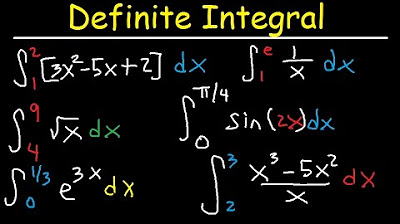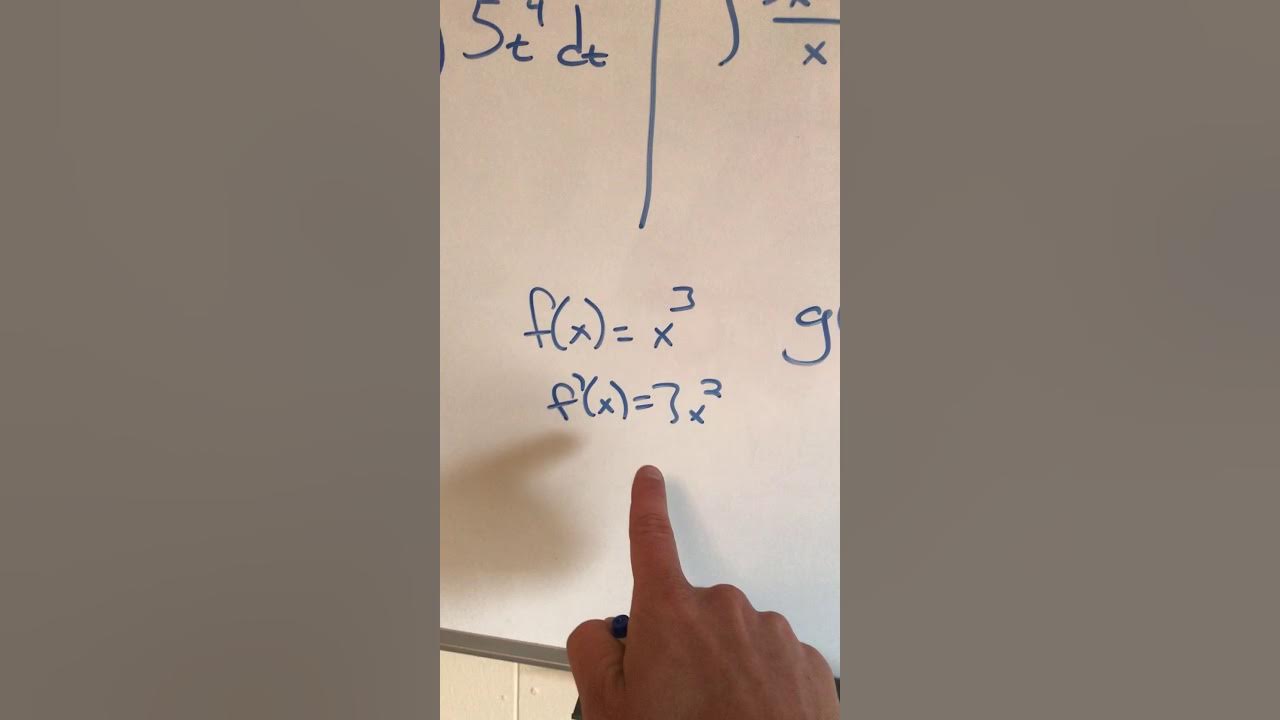Basic Integration Using Power Formula (Live Stream)
TLDRThe video script is an in-depth walkthrough of various integral calculus problems, focusing on the application of techniques like power rule, u-substitution, and chain rule. The speaker systematically solves a series of integrals, starting from basic to more complex ones, demonstrating the step-by-step process of evaluating integrals. The video is an educational resource for viewers interested in enhancing their understanding of calculus, particularly in integrating polynomial, rational, and radical functions.
Takeaways
- 📚 Integral calculus is the focus of the discussion, with various integral problems being solved throughout the session.
- 🔢 The power rule for integration is a recurring theme, used to evaluate integrals of the form ∫x^n dx, where n ≠ -1.
- 🌟 The use of u-substitution is highlighted as a key technique for solving more complex integrals that don't fit the direct application of the power rule.
- 📈 Examples of integrals solved include those involving square roots, fractions, and higher powers, demonstrating the versatility of integration methods.
- 🎓 The importance of understanding the properties of exponents and radicals is emphasized for transforming integral expressions into integrable forms.
- 🤝 The video includes shout-outs to viewers, indicating an interactive and engaging approach to teaching complex topics like integral calculus.
- 📝 The script provides detailed step-by-step solutions, making it a valuable resource for learners looking to understand the process of integrating various functions.
- 🌐 The content is delivered in a conversational tone, which may make the material more accessible to a wider audience.
- 🎓 Emphasis is placed on the importance of simplifying expressions and correctly applying mathematical laws to find the final answers.
- 📊 The session covers a range of problems, showcasing the problem-solving process in integral calculus and the application of different substitution techniques.
- 📈 The script serves as a comprehensive guide to tackling integral calculus problems, providing both the methods and the rationale behind each step.
Q & A
What is the integral of x squared dx?
-The integral of x squared dx is x cubed divided by 3 plus C, where C is the constant of integration.
How does the power rule for integration work?
-The power rule for integration states that the integral of x raised to the power of n, where n is not equal to -1, is x raised to the power of n+1 divided by n+1 plus C.
What is the significance of the constant C in indefinite integrals?
-The constant C represents the arbitrary constant of integration, which accounts for the infinite number of possible functions that could represent the antiderivative of a given function.
How can you evaluate the integral of a sum of terms?
-To evaluate the integral of a sum of terms, you can distribute the integral symbol with the dx and integrate each term separately, then add the results together.
What is the integral of 2x raised to one half plus x dx?
-The integral of 2x to the power of 1/2 plus x dx is 2 times the integral of x to the power of 1/2 dx plus the integral of x dx, which simplifies to 2 times (3/3) times x to the power of 3/2 plus (1/2) times x squared plus C.
How do you handle radical expressions in integration?
-Radical expressions in integration can be transformed into fractional exponents. For example, the square root of x can be written as x to the power of 1/2, and then the integral can be evaluated using the power rule.
What is the integral of x times the square root of x dx?
-The integral of x times the square root of x dx is x to the power of 3/2 plus 1 divided by (3/2 + 1) plus C, which simplifies to (2/5) times x to the power of 5/2 plus C.
How does u-substitution work in integration?
-U-substitution is a technique used in integration where a variable or an expression is replaced with a new variable u. The derivative of u with respect to x (du/dx) is then found, and the integral is solved in terms of u before substituting back to x.
What is the integral of dx over the fifth root of x?
-The integral of dx over the fifth root of x is x raised to the power of 4/5 divided by (4/5) plus C, which simplifies to (5/4) times x to the power of 4/5 plus C.
How do you evaluate the integral of a polynomial divided by a power of x?
-To evaluate the integral of a polynomial divided by a power of x, you can use u-substitution where u is the power of x. You then differentiate both sides with respect to x, solve for du/dx, and integrate term by term.
Outlines
📚 Introduction to Integral Calculus
The video begins with an introduction to integral calculus, focusing on solving basic integral problems. The first example involves evaluating the integral of x squared with respect to dx. The presenter uses the power rule for integration, which states that the integral of x to the power of n is x to the power of n+1 divided by n+1 plus c, where n is not equal to -1. The integral is evaluated as x cubed over 2 plus c. The video then moves on to more complex integrals, demonstrating the distribution of the integral symbol and the application of the power rule to multiple terms.
🔍 Evaluating Definite Integrals
This paragraph delves into evaluating definite integrals, starting with the integral of 2x raised to the power of 1/2 plus x with respect to dx. The presenter shows how to distribute the integral symbol term by term and apply the power rule to each term. The integral of 2x to the power of 1/2 is evaluated, and then the integral of x is simplified. The final answer is presented as a combination of these results. The video then tackles the integral of x times the square root of x, transforming the radical into a fractional exponent and applying the power rule to find the final answer.
🌟 Advanced Integration Techniques
The video continues with more advanced integration techniques, including the use of u-substitution. The presenter demonstrates how to evaluate the integral of dx over the fifth root of x by transforming the radical into a fractional exponent and applying the power rule. The video then presents a complex integral involving x squared minus 3x squared plus x divided by x, where the presenter uses distribution and simplification to evaluate the integral term by term. The power rule is applied to each term, and the final answer is presented.
📈 Integration of Polynomial Functions
This section focuses on the integration of polynomial functions. The presenter introduces the problem of integrating x to the fourth minus 3x squared plus x divided by x. The integral is evaluated using distribution and simplification, with the power rule applied to each term. The integral of x to the fourth divided by x simplifies to x cubed, and the integral of x squared over x simplifies to x. The integral of dx is x plus c, and the final answer is presented with all terms simplified.
🧮 Solving Integral Calculus Problems
The video concludes with a series of integral calculus problems, each solved using various techniques such as direct application of the power rule, u-substitution, and simplification of complex expressions. The presenter evaluates integrals involving polynomial functions, radicals, and more complex algebraic expressions. The use of substitution is particularly highlighted, with the presenter showing how to choose the appropriate u for substitution based on the complexity of the expression. Each problem is solved step by step, with the final answers presented in a clear and concise manner.
🎓 Final Thoughts on Integral Calculus
In the final paragraph, the presenter wraps up the video by summarizing the techniques used for solving integral calculus problems. The focus is on the importance of understanding basic integration, complex integration, and advanced integration techniques such as u-substitution. The video ends with a reminder of the practical applications of integral calculus and encourages further exploration of the subject.
Mindmap
Keywords
💡Integral Calculus
💡Power Rule
💡U-Substitution
💡Chain Rule
💡Differential Equations
💡Antiderivatives
💡Integration Techniques
💡Constants
💡Derivatives
💡Fractional Exponents
💡Complex Integration
Highlights
Introduction to integral calculus and problem-solving techniques.
Evaluation of the integral of x squared using the power rule formula.
Integration by term distribution and application of the power rule for multiple terms.
Transforming radicals into fractional exponents for integration.
Using the power rule to evaluate integrals with exponents of negative numbers.
Integration by substitution for more complex integrals.
Solving integrals with multiple terms through u-substitution and simplification.
Integration of functions with radicals by squaring both sides and simplifying.
Applying u-substitution for integrals involving complex expressions.
Integration of a function with a constant term through basic integration techniques.
Using u-substitution for integrals with higher degree polynomials in the denominator.
Integration of a function with a square root and a polynomial through substitution and simplification.
Solving integrals with complex denominators using u-substitution and power rule.
Integration of a function with a cube root and a polynomial through substitution and simplification.
Using substitution to evaluate integrals with complex numerators and simpler denominators.
Integration of a function with a cube and a polynomial through substitution and power rule application.
Solving integrals with complex expressions using u-substitution and distribution.
Integration of a function with a square root and a polynomial through substitution and power rule.
Using substitution to evaluate integrals with complex expressions and exponents.
Integration of a function with a cube and a polynomial through substitution and simplification.
Solving integrals with complex expressions using u-substitution and power rule.
Integration of a function with a square root and a polynomial through substitution and simplification.
Using substitution to evaluate integrals with complex expressions and fractional exponents.
Integration of a function with a square root and a polynomial through substitution and power rule.
Solving integrals with complex expressions using u-substitution and distribution.
Transcripts
Browse More Related Video

Definite Integral Calculus Examples, Integration - Basic Introduction, Practice Problems

Calculus 1: U-Substitution Examples

Integration of Rational Functions By Completing The Square - Calculus

Email Answer about When To Use U-Sub

Calculus 1 - Integration & Antiderivatives

AP Calculus AB Crash Course Day 5 - Integration and Differential Equations
5.0 / 5 (0 votes)
Thanks for rating: